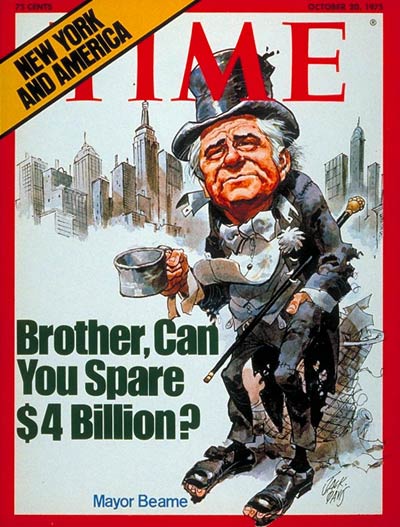History

NYC in desperation in the 1970s
The 70’s fiscal crisis was a profound event in New York City’s history. For two decades prior to 1975, NYC’s accounting practices were bordering on incompetent to outright fraud. The city engaged in many fiscal gimmicks, such as having a hidden past deficit, overestimating revenues, understating expenditures and so forth. In the 1970s, the financial mismanagement of New York City contributed to its collapse.
In addition to financial mismanagement, there were many long-term causes of this crisis. In the 60s and 70s, NYC’s social welfare programs had simply become too large. As a result of the expansion of the welfare programs, more and more of the city’s revenues went to the welfare programs. NYC had also experienced massive job losses due to the de-industrialization of the city. With the rise of containerized manufacturing, manufacturing had become a dying sector. As the city’s manufacturing jobs fled, more and more of New Yorkers were left unemployed.
In the 1960s and 70s, the city’s crime rate consistently increased over time. Murders occurred frequently around the city. The city was vulnerable to racial tensions. In 1967, the Brooklyn Borough President said that “the streets are unsafe to walk on.” In the face of an unsafe city and often the appeal of the suburbs, many New Yorkers chose to move out of the city. As many of its residents chose to leave the city, New York City was left with a dwindling tax base.
Another cause of the fiscal crisis was the large, bloated contracts the unions had received. City politicians in the two decades prior to 1975 wanted labor peace at all costs, and thus did anything to appease them. The pension benefits of union workers were very large, and thus this hurt the city even more.
Decisions of the federal government also contributed to the city’s collapse. In 1974, the federal government changed the way in which it funded cities. The federal government adopted the Community Development Block Grant Program.In this program, the federal government funded without any “strings attached.” This program was insufficient to cover New York City’s needs. Soon the city and state tensions rose over the funding.
The market also faced a severe stock market crash between 1973 and 1974. This was considered the seventh worst crash in history, lasting for 694 days. The stock market suffered a total loss of 45.1% of share values. The dollar suffered a severe devaluation as President Nixon chose to pull out of a much-respected monetary managing system, the Bretton Woods System. As the American economy was in shambles, New York City’s economy also suffered.
The decade also witnessed an international affair that had a tremendous negative impact upon economies throughout the world. That affair was the Arab Oil Embargo of 1973. On October 5, 1973 members of OAPEC declared an embargo on oil, due to America’s support of Israel in the Yom Kippur War. This led to dramatic inflation of oil, quadrupling the price from $4 to $12 a barrel. This was a shock to the Western countries, as it deepened the current recession, and constricted the world economy, as NYSE shares lost $97 billion dollars. It further affected the tax base of NYC, since it caused an economic recession, and tightened the market for municipal bonds.
As New York City was fiscally mismanaged, its fiscal programs too large, its deindustrialization contributing to job losses, and left with a dwindling tax base, New York City was truly in a state of crisis.

Burnt down tenement building in the Bronx in the late 70s